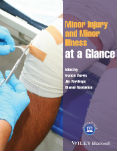-
1. Name five complications of a fracture of the maxilla.
Show Answer
Correct answer:
- Diplopia
- Decreased sensation inferior orbital nerve
- Eyelid subcutaneous air (after blowing nose)
- Eye injuries
- Trapping of inferior orbital muscles (blow-out fracture)
See Chapter 13.
-
2. In blunt trauma the maxilla often fractures at which four points?
Show Answer
Correct answer:
- The inferior orbital rim
- The fronto-zygomatic suture
- The lateral wall of the maxillary antrum
- The zygomatic arch
See Chapter 13.
-
3. Name two wounds that require very careful repair.
Show Answer
Correct answer:
- A wound crossing the vermillion border of the lip
- A wound crossing the margin of the eyelid
See Chapter 13.
-
4. List the essential components of an eye examination in a non-specialist setting.
Show Answer
Correct answer:
- Visual acuity
- Inspection of lids and subtarsal area, conjunctiva and cornea. Fluorescein if corneal pathology suspected
- Pupillary and iris examination for size, symmetry, reaction and irregularity
- Anterior chamber for blood/cells/bulging
- Possibly visual fields, fundoscopy and slit-lamp examination
See Chapter 14.
-
5. Match the diagnosis of a red eye with the following clinical features.
(a) Red, painful eye, with nausea, vomiting, a hazy cornea and visual halos. Pupil is mid-dilated and reaction is sluggish. The eye feels hard.
(b) Painful unilateral red eye with photophobia and blurry vision. Pupil is irregular and poorly reactive.
(c) Red, sore eye with a sensation of a foreign body. Fluorescein reveals branching/spider-like lesion.
(d) Otherwise asymptomatic, bright red well-demarcated patch on the conjunctiva.
(e) Bilateral itchy, runny eyes with oedematous conjunctiva.
Show Answer
Correct answer:
(a) Red, painful eye, with nausea, vomiting, a hazy cornea and visual halos. Pupil is mid-dilated and reaction is sluggish. The eye feels hard.
Acute glaucoma
(b) Painful unilateral red eye with photophobia and blurry vision. Pupil is irregular and poorly reactive.
Anterior uveitis
(c) Red, sore eye with a sensation of a foreign body. Fluorescein reveals branching/spider-like lesion.
Dendritic ulcer
(d) Otherwise asymptomatic, bright red well-demarcated patch on the conjunctiva.
Subconjunctival haemorrhage
(e) Bilateral itchy, runny eyes with oedematous conjunctiva.
Allergic conjunctivitis
See Chapter 14.
-
6. What are the clinical features of orbital cellulitis?
Show Answer
Correct answer:
- Painful, unilateral red swollen eyelid
- May be systemically unwell with fever
- May have proptosis, fever
- May have chemosis and reduced vision
- Limited or painful eye movements
See Chapter 14.
-
6. A 21-year-old man presents soon after having his first upper incisor knocked out during a rugby game. He has no other injuries and has brought the tooth wrapped in tissue paper. What is your management?
Show Answer
Correct answer:
(a) Immediate reimplantation
(b) Before implantation, gently clean the tooth with saline
(c) Ideally, local anaesthetic and gentle cleaning of socket
(d) Replace the tooth in the socket and compress it. If the tooth does not seat easily, get the patient to bite on some gauze
(e) The patient should be given oral antibiotics (metronidazole), analgesia and chlorhexidine mouthwash
(f) Follow-up with a dentist for splintage should be arranged
See Chapter 15.

